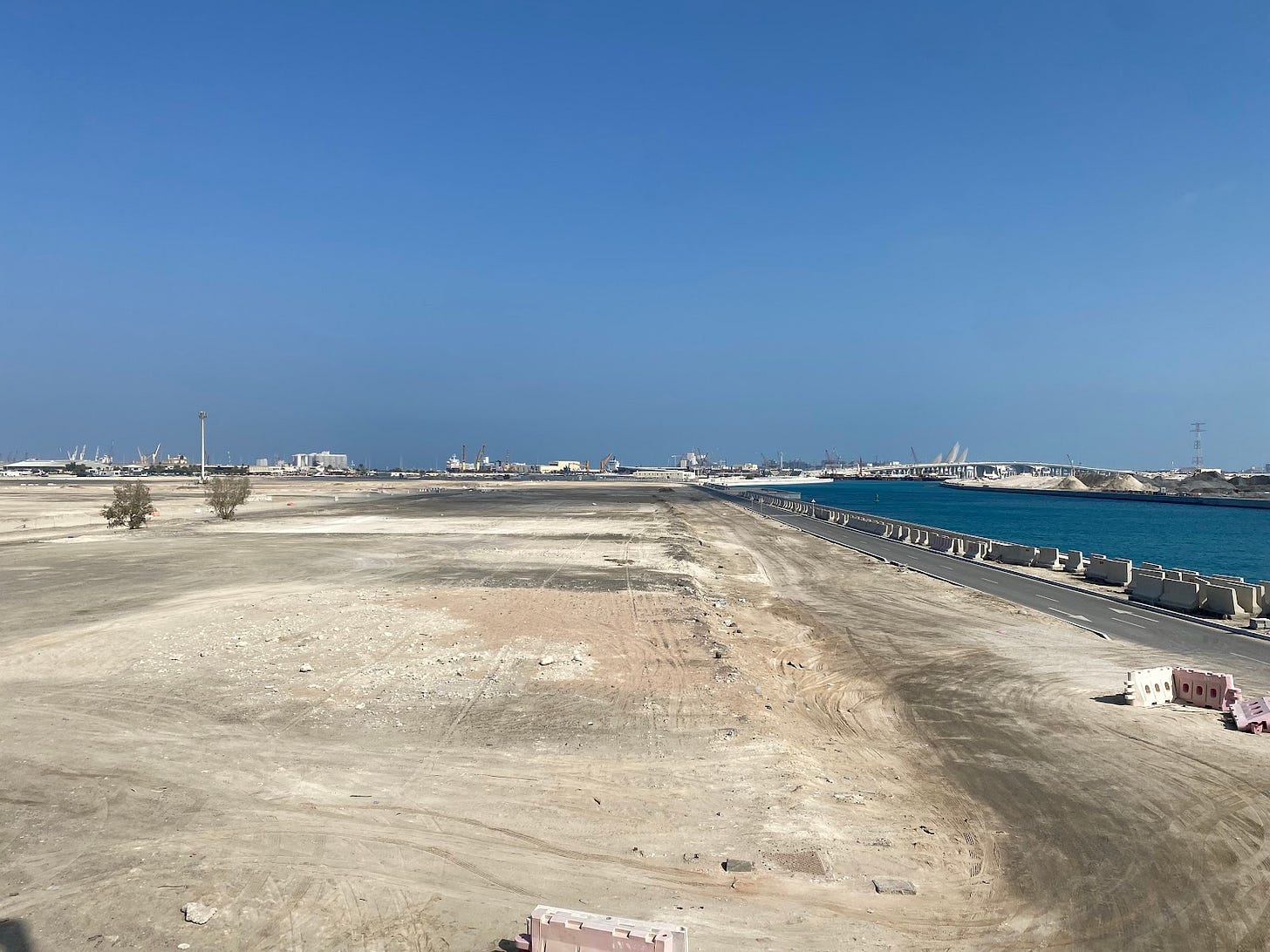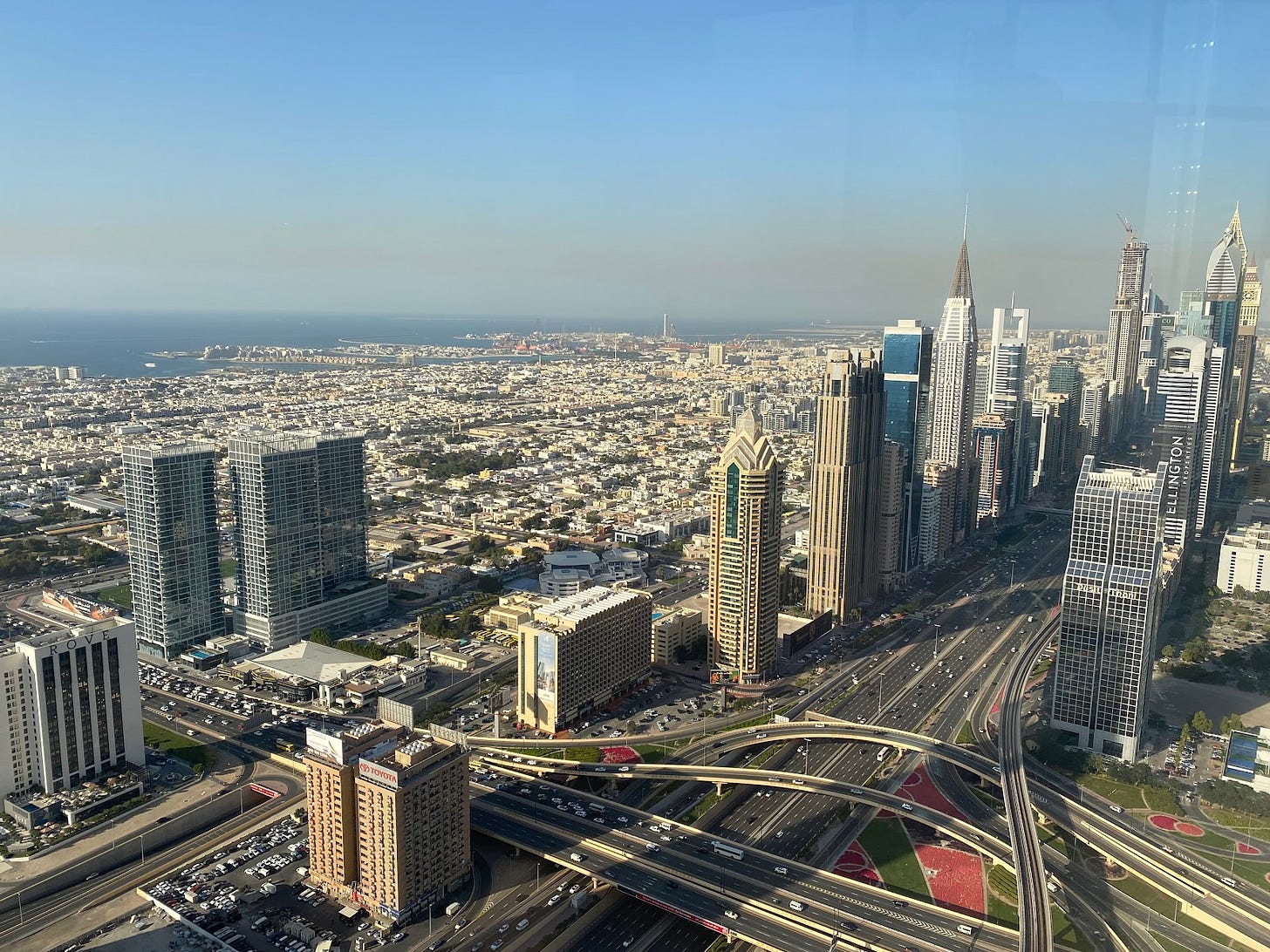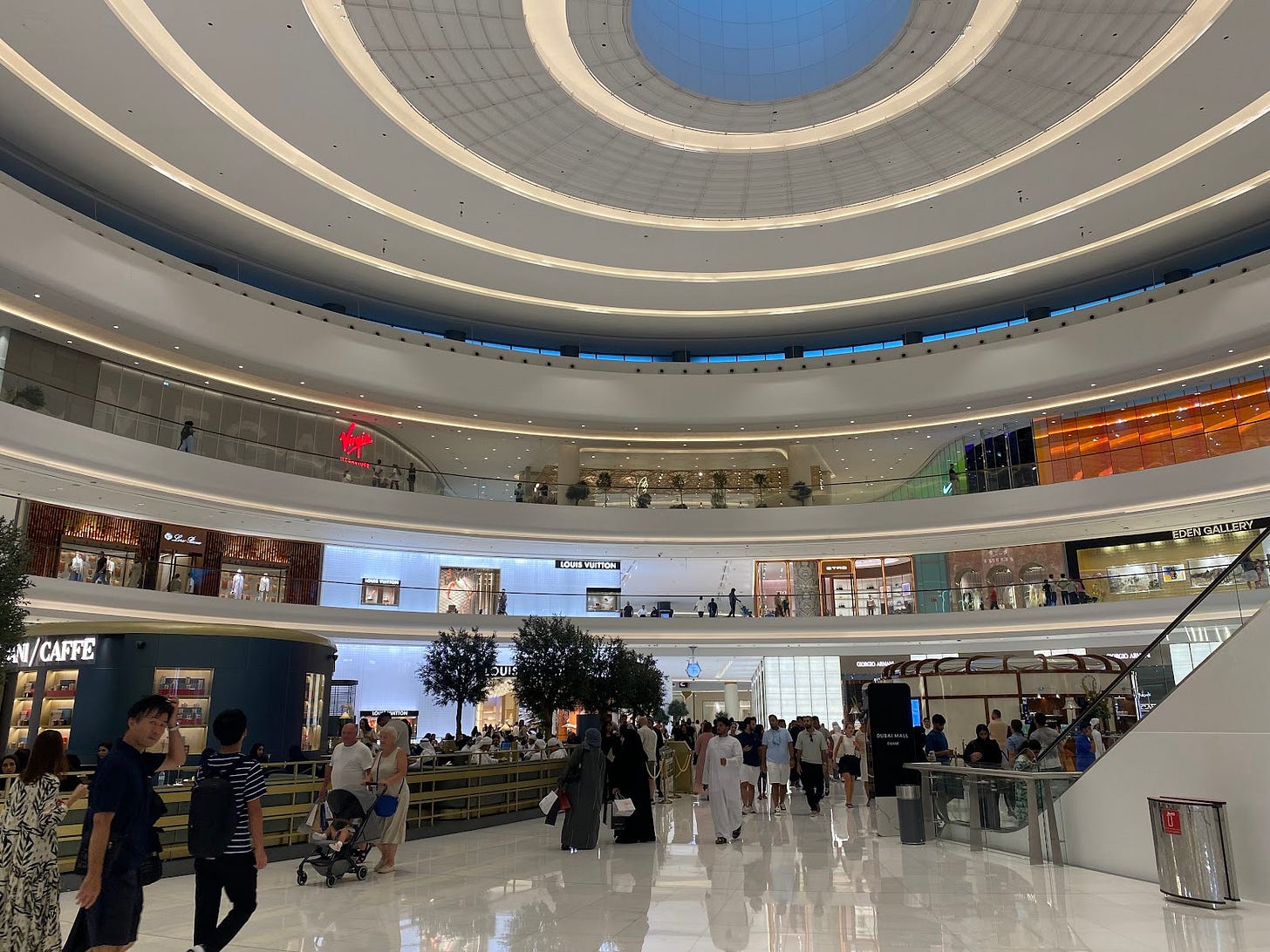This is the third in a short series of three pieces on urbanism in the United Arab Emirates. Here are the first and second.
Abu Dhabi locals I've spoken to often define their city in terms of Dubai, the glitzy growth juggernaut 90 minutes up the dusty highway. Dubai has an undeniably assured sense of itself and seems settled in its brashness and role as site of spectacle, accumulation, and consumption. The locals told me Abu Dhabi was more relaxed, quieter, and less intense, in the way second cities often are.
This isn't self-effacement; I also sensed pride and confidence in Abu Dhabi. The city sprawls outward, with neighborhoods on the rise and rapid development that is as likely to meet existing growth needs as to invite more of that growth. To the outsider, Abu Dhabi seems to see itself as the more grown-up and cultured counterpart to the flash of Dubai. There’s a palpable sense of making—or maybe, more precisely, manufacturing—place and meaning out of marsh, sand, and flatness. Al Maryah was one piece in that larger puzzle: a previously empty island, much of it artificial and reclaimed from the brackish waters, that will become a kind of place, and an expression of what Abu Dhabi wants to be.
Citymaking takes vision, and it takes people. Ultimately, it takes deep thought about what a city is. It takes consideration of where and how people want to spend their time in the city, and an understanding of the kinds of urban environments they will respond to. Developers are as adept as urban designers at understanding what drives people to linger and enjoy urban spaces, in part because compelling places support a developer’s profit motive. Compelling places make money. As Dubai and Abu Dhabi both pursuing developer-driven placemaking strategies, their modes and results markedly diverge.
Dubai seems to believe that people want their places packaged, comfortable, and immediately legible. They want to arrive in air-conditioning, they want to spend their time in air-conditioning, and they each the experience spelled out for them. The cityscape of Dubai rests on the overriding assumption that what people truly want is to consume. It’s a theme park version of urban life, not altogether different from the ersatz downtowns of Disney’s actual theme parks. For all of Dubai’s considerable resources and architectural bombast, the result of this urban development mode is an astonishing dumbing down of civic life.
Both cities are growing at breakneck speed, and in the process are following planning modes that are disproven or broken in Western cities. The UAE's embrace of an automobile-first planning paradigm requires each city to organize itself at all scales in ways that are fundamentally at odds with the human-scaled places that human beings love most and flock to. Abu Dhabi and Dubai are replicating the midcentury sins that American cities grapple with and European cities are making headway toward undoing: car dominance, separation of uses, and wildly overscaled design.
It is obvious that the oil-rich emirates would put carbon-fueled transportation first. It’s more surprising to discover that each city seems to have a different idea of what a city is. Dubai pursues endless growth in isolated and self-contained clusters that have no civic interrelationship to each other and make no contribution to a connected urban whole. In Abu Dhabi, however, the city’s natural network of waterways and pattern of islands seems to have fostered greater connectedness and facilitated an urban vision that is more cohesive than Dubai's isolated development pods. Al Maryah suggests at least some nod toward walkability, some foothold gained for civic space, some potential of a future city where one part connects to the others to make a networked whole, cohesive and coherent.

Back in the hammam in Abu Dhabi, my local acquaintance awaited my answer: What had I seen of his city? I told the truth: I’d mostly just walked around the island and the nearby mainland neighborhoods. He scoffed, unimpressed that I’d not visited the official sites and major attractions. But I took some quiet satisfaction in knowing that I might have gained more insight on the city than if I’d jumped in a cab from the forecourt of my hotel and spent a day poking around the mosque and the palace and then blown a bunch of cash at Ferrari World. By traversing a small portion of the developing city on foot, I’d seen older neighborhoods and newer ones up close, in the open air and at a human pace, rather than at high speed from behind a windscreen. I’d engaged with how the city presents itself today, and contemplated the very different way it imagines its future. I’d absorbed some of the texture of this new extension of the central city, which strives to become more walkable, and both urban and urbane, and considered what it might achieve in defining a different future for Emirati cities. Having also beaten a footpath through (several small corners of) Dubai, I began to conceive of the differences between these two sprawling coastal cities in the context of ideas each holds about the kind of urbanity they aspire to achieve.
It underscored a lesson I learned when I first moved to New York, fresh out of college. I spent my first hours there, on a steamy summer night, walking the length of Broadway from the Battery to Columbus Circle, a route that traces the history and aspiration of that city on a single street. I learned LA the same way, defying the city’s cultural norms by walking, biking, and taking transit wherever I could, which intimately revealed the gobsmacking beauty and confounding challenges of that most global of cities. In every place I live and visit, I learn most on my feet, eyes open, moving at human speed.
As an urbanist, it’s deeply rewarding to grapple with these cities. I live in Paris, which is a masterpiece of walkable, human-scaled urbanism, and which continues to pursue superb public space initiatives, an aggressive regulatory stance toward the car, and visionary infrastructure projects that will better connect the tiny and wealthy central city to its much larger and more diverse metropolitan region.
But, as cities go, Paris is mostly a done deal. It’s about refinement now, adapting the ancient city to meet its many contemporary challenges. Abu Dhabi and Dubai, and other Middle Eastern cities, are still defining what kind of cities they want to be. They are wrestling with what cities are. And they are confronting how meaning can be built from emptiness, and at great speed. Dubai’s answers mostly disappoint, with its reckless reliance on automobiles and air conditioning, its sprawling and disconnected urban landscape, and its focus on consumption. Abu Dhabi suggests that a different path is possible—sprawling and environmentally disastrous, still, yes, but with a nascent civic quality at its core that questions previous assumptions and makes a case for a more engaging and civic growth mode. There’s even a whisper of hope in there: that the reward of a richer urbanism might be an opening toward a more open, freer, and more democratic future for my friend at the hammam and the global masses who are reshaping this land of endless sand, glittering water, and big ideas.




This is the best one in the trilogy of posts ! So fascinating! If I had to go to the UAE, I’d want you there to comment along the way.